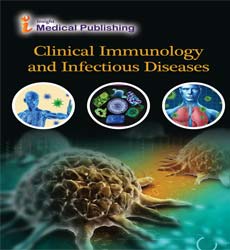Vaccine-Induced Immunity and Breakthrough Infections: A Clinical Perspective
Bektas Selmin*
Department of Medicine at University of Medicine and Dentistry New Jersey-Rutgers, Newark
Corresponding author:
Bektas Selmin,
Department of Medicine at University of Medicine and Dentistry New Jersey-Rutgers, Newark,
E-mail: bektas@selmin.nk
Received date: January 01, 2025, Manuscript No. Ipciid-25-20578; Editor assigned date: January 03, 2025, PreQC No. Ipciid-25-20578 (PQ); Reviewed date: January 15, 2025, QC No. Ipciid-25-20578; Revised date: January 22, 2025, Manuscript No. Ipciid-25-20578 (R); Published date: January 28, 2025, DOI: 10.36648/.9.1.3
Citation: Selmin B (2025) Vaccine-Induced Immunity and Breakthrough Infections: A Clinical Perspective. J Clin Cardiol Cardio ResVol.9 No.1:3
Abstract
Introduction
Vaccine-induced immunity represents a cornerstone of infectious disease control, eliciting humoral and cellular responses that reduce infection risk, severity, and transmission; however, the occurrence of breakthrough infections cases of disease in fully vaccinated individuals highlights important nuances in vaccine effectiveness, waning immunity, pathogen evolution, and host factors, all of which shape clinical management and public-health strategies in the post-vaccine era [1].
Description
Mechanisms of vaccine-induced protection center on neutralizing antibodies that block pathogen entry and on T-cell responses that eliminate infected cells and shape durable immunity; different vaccine platforms (mRNA, viral vector, protein subunit, inactivated) produce varying magnitudes and qualities of these responses, which interact with host age, comorbidities, and prior exposures to determine individual protection Clinically, most breakthrough cases are milder than infections in unvaccinated persons because primed cellular immunity limits viral replication and systemic inflammation; nevertheless, severe outcomes can still occur in high-risk groups, and some breakthroughs may contribute to onward transmission [2]. The kinetics of antibody waning and the persistence of memory B and T cells both matter: circulating neutralizing titers correlate with protection against infection, while memory responses often preserve protection against severe disease by mounting rapid secondary responses upon exposure. Which helps explain why sterilizing immunity is uncommon and why breakthrough infections especially mild or asymptomatic can still occur Breakthrough infections arise from a combination of Factors: declining neutralizing antibody levels over time Antigenic drift that reduces vaccineâ??pathogen match, high exposure dose or immune-evasive variants, and individual host vulnerabilities such as immunosuppression or age [3]. Produce varying magnitudes and qualities of these responses, which interact with host age, comorbidities, and prior exposures to determine individual protection. Management pivots on early recognition of high-risk patients and timely use of adjunctive therapiesâ??antivirals, monoclonal antibodies (when active against circulating variants), and supportive care while acknowledging that treatment choice depends on variant susceptibility and patient comorbidities From a population and policy perspective, breakthrough infections inform booster strategies, vaccine reformulation, and non-pharmaceutical interventions: surveillance of vaccine effectiveness guides timing and target groups for booster doses to restore antibody levels, while genomic monitoring signals when antigenic changes warrant updated vaccine antigens [4] Communication is criticalâ??framing vaccines as highly effective at preventing severe disease and death, even if imperfect at preventing all infections preserves public trust. Finally, equity in vaccine access, transparent data on effectiveness and breakthrough risk, and integrated strategies combining vaccination with therapeutics and public-health measures remain essential to minimize morbidity, mortality, and healthcare strain. [5].
Conclusion
In summary, vaccine-induced immunity substantially reduces the burden of infectious disease and blunts severity, but breakthrough infectionsâ??driven by waning immunity, variant evolution, exposure intensity, and host factorsâ??require dynamic clinical and public-health responses that include targeted boosters, variant-adapted vaccines, early therapeutics for vulnerable patients, and continuous surveillance to sustain protection at both individual and population levels a layered approach that combines adaptive vaccination, therapeutics, and health-system preparedness will be essential to mitigate the evolving challenges of breakthrough infections and sustain long-term control of infectious diseases.
Acknowledgement
None.
Conflict of Interest
None.
References
- Niazi SK (2025) Regulatory Perspectives for AI/ML Implementation in Pharmaceutical GMP Environments. Pharmaceuticals 18: 901
Google Scholar Cross Ref Indexed at
- Schumacher TN, Schreiber RD (2015) Neoantigens in Cancer Immunotherapy. Science 348: 69–74
Google Scholar Cross Ref Indexed at
- Lowdell MW (2024) Considerations for Manufacturing of Cell and Gene Medicines for Clinical Development. Cytotherapy 27: 874–883
Google Scholar Cross Ref Indexed at
- Hargrave A, Mustafa AS, Hanif A, Tunio JH, Hanif SNM (2023) Recent Advances in Cancer Immunotherapy with a Focus on FDA-Approved Vaccines and Neoantigen-Based Vaccines. Vaccines 11: 1633
Google Scholar Cross Ref Indexed at
- Caballero-Ávila M, Martin-Aguilar L, Collet-Vidiella R, Querol L, Pascual-Goñi E (2025) A Pathophysiological and Mechanistic Review of Chronic Inflammatory Demyelinating Polyradiculoneuropathy Therapy. Front Immunol 16: 1575464
Google Scholar Cross Ref Indexed at
Open Access Journals
- Aquaculture & Veterinary Science
- Chemistry & Chemical Sciences
- Clinical Sciences
- Engineering
- General Science
- Genetics & Molecular Biology
- Health Care & Nursing
- Immunology & Microbiology
- Materials Science
- Mathematics & Physics
- Medical Sciences
- Neurology & Psychiatry
- Oncology & Cancer Science
- Pharmaceutical Sciences
